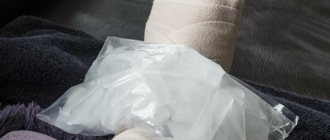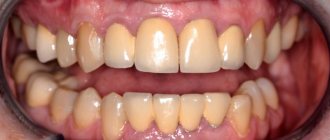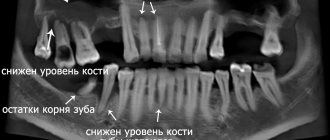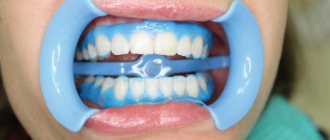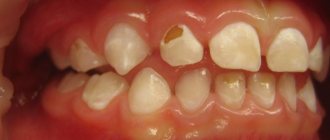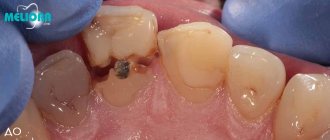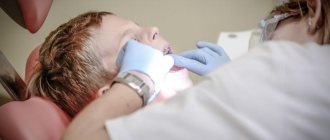What is Priestley plaque on teeth?
This is a dental problem that occurs in children. In this condition, deposits are found on the enamel of the teeth. Dark plaque on a child’s teeth can be black or brown, sometimes with a light or pearlescent tint. As a rule, it is located as a thin border along the lower edge of the teeth closer to the gums. But plaque can also cover a large area of the tooth or look like a small spot on the enamel. Most often, dark deposits appear on the inside of the teeth, less often in the interdental space or on the outer surface of the teeth.
Photo courtesy of InWhite Medical Clinic
How to detect dark plaque in time
- regularly examine the child’s oral cavity independently;
- do not postpone scheduled visits to the dentist.
It must be taken into account that Priestley plaque on the teeth often accumulates slowly, which is why the child gets used to the stains on the enamel and does not tell his parents about them. Darkening of teeth can occur quickly, literally overnight. Reactive appearance most often occurs during illness, accompanied by intoxication, dehydration and increased body temperature. This is due to the fact that the child’s body reacts sharply to various changes in diet, the functioning of internal organs and in external conditions.
Deposits most often occur at the age of 2-3 years. However, they can also appear on the very first milk teeth of a one-year-old child. Or it could affect the baby teeth of a younger teenager who haven’t had time to change. The darkening may also spread to permanent teeth.
Why is this happening?
Sometimes treatment allows you to regain lost whiteness, and sometimes the changes are irreversible, but this process still cannot be ignored. The main thing is to correctly determine the cause.
- Poor or lack of oral hygiene. Plaque of food debris on the surface of the enamel thickens over time and absorbs dyes, which leads to blackening.
- Regular consumption of drinks and foods containing dark food pigments.
- Unhealthy diet, vitamin deficiency and the predominance of sweets in the diet.
- Development of caries. A small dark spot quickly increases in size, and if the carious cavity deepens inward, the internal affected areas turn black.
- Due to trauma, the vascular bundle inside the pulp is sometimes damaged. The hematoma gives the tooth a characteristic dark shade.
- Taking certain drugs, for example antibacterial ones from the tetracycline group, also leads to blackening of the enamel. The medicine accumulates in the tissues - even the first tooth may be black.
- Also, teeth turn black after silvering - applying a solution with silver ions to the caries-affected surface.
Why does a child have black plaque on his teeth?
The main problem with the appearance of Priestley plaque on teeth is not that it causes bad breath, looks unsightly, or cannot be removed independently without the help of a hygienist. Priestley's plaque is a signal that something has changed in the child's body, due to which non-dangerous bacteria began to actively multiply, creating deposits. And for high-quality treatment and prevention of the development of diseases, it is necessary to find out why black plaque forms on the teeth, the reasons for the appearance of beneficial living conditions for bacteria.
Possible causes of plaque:
➢
diabetes;
➢
genetic feature or hereditary predisposition;
➢
thyroid diseases;
➢
incorrectly selected hygiene products;
➢
parasite infection.
Dysbacteriosis.
Disruption of the gastrointestinal tract can occur due to malnutrition, food poisoning, immaturity of the digestive system, taking antibiotics or chronic diseases of the stomach, liver, and intestines.
Caries.
Due to the fact that parents usually do not brush their baby’s first teeth, yellow plaque begins to accumulate on the enamel, which over time can cause caries. Irregular or insufficiently high-quality tooth brushing by the child himself also leads to the formation of caries. Carious lesions create a favorable environment for the growth of bacteria, which causes Priestley plaque to appear on baby teeth.
Dehydration.
Due to dehydration due to various reasons, the body cannot produce enough saliva to wash the teeth and remove food particles. Because of this, bacteria begin to multiply faster, and a dark plaque forms on the child’s teeth. Therefore, it is important to ensure that your baby gets enough fluids, especially in hot weather or during illness.
Hypoplasia of tooth enamel.
Some children have underdeveloped top layer of enamel. It is weakened and unable to perform a protective function.
Disorders of dental development in the prenatal period.
Dental buds may be damaged during development due to viral infections suffered by the mother, calcium deficiency, iron deficiency, or taking certain medications.
Improper functioning of the immune system.
Malfunctions in the immune system can affect the body's ability to suppress bacterial activity.
Malocclusion.
If a child has a malocclusion, the load on the jaw when chewing is distributed unevenly, which is why some of the teeth receive increased load, but are cleansed with solid food: carrots, apples. And unused teeth become covered with plaque.
Why do baby teeth turn black?
One of the most common causes of darkening of a child's teeth is caries. Caries is an infectious disease caused by special microorganisms. One-year-old babies often develop bottle caries, which instantly affects children's teeth one after another.
Causes of caries
- Very rapid development of an infectious environment in the child’s mouth. The source of infection is the saliva of an adult or parents when transmitting their microflora through shared cutlery, kissing, and licking the nipple.
- Damage to teeth due to trauma.
- Sudden temperature changes (when eating).
- Feeding your baby at night, even infants. A child who falls asleep with only a bottle of formula, milk or juice in his mouth puts his teeth at risk of developing caries. Since saliva stops washing the baby’s mouth during sleep, the acid produced by bacteria remains on the tooth enamel for a long time and destroys them.
- Lack of hygiene of baby teeth or poor quality of hygiene.
There are other reasons why baby teeth turn black:
- If the baby's body does not absorb enough calcium. Against the background of impaired metabolism, calcium begins to be poorly absorbed by the body and is not supplied in sufficient quantities for its intended purpose.
- Genetic predisposition. It has already been precisely determined that heredity directly affects the structure of the enamel and the chemical composition of saliva, and it follows that heredity predetermines susceptibility to dental pathologies.
- Permanent plaque. It occurs due to decreased salivation, impaired saliva composition, poor oral hygiene and lack of drinking regime.
- Frequent presence of various sweets in the child’s diet. A large amount of simple carbohydrates in a baby’s diet increases the acidity in the mouth and thereby contributes to the occurrence of caries.
- Impaired metabolism.
- Poor absorption of fluoride. Fluoride accumulates in the body, but is not absorbed or excreted. Externally, this disease manifests itself as darkening of the enamel or specific stripes.
- The child has chronic diseases, for example, gastritis, diabetes, iron deficiency anemia, etc. Such diseases affect the entire body as a whole, including the condition of the teeth.
- A certain number of medications. The use of products containing iron, necessary for the treatment of anemia, as well as a course of treatment with tetracycline antibiotics (during pregnancy or in the first 6 months after birth) can lead to darkening of the baby’s teeth.
Diagnosis of Priestley plaque on teeth
If darkening is detected on the enamel of a child’s teeth, you must contact a dental clinic.
The specialist will:
✔
inspection;
✔
laser diagnostics to determine the depth and size of the lesion;
✔
anamnesis collection.
After a conversation with the parent and child and collecting an anamnesis, the pediatric dentist will immediately prescribe treatment or conduct an additional examination. You should not neglect it - it is important for a specialist to find out why the child has black plaque on his teeth. Only after this will he be able to provide quality treatment.
How is a bruise diagnosed?
How to behave if a child’s tooth has darkened after a blow? Try to remain calm, the child needs to be shown to the dentist urgently. The doctor will order an x-ray examination, on its basis it will be possible to make a diagnosis. A visual inspection of the damaged area is also performed, the severity of the injury is determined and treatment is prescribed.
The attending physician will tell you how long it will last and by what means it will be performed. Be sure to insist on an x-ray examination, because only an x-ray can reveal all possible disorders and consequences that the injury could lead to.
An impact may result in a fracture of the tooth root, or significant trauma to the alveolar process. These injuries are dangerous and without appropriate treatment can cause irreparable harm not only to baby teeth, but also to permanent teeth.
The first days, treatment should take place under the close supervision of a doctor. The doctor continues to examine the affected area and at the first symptoms of tissue death, immediately removes the affected parts. This prevents further spread of necrosis.
Additional protective measures for Priestley's raid
It is possible that Priestley's plaque on the teeth appeared due to an infection and, as a result, a temporary deterioration in the functioning of the immune system. But it is necessary to make sure that there are no serious and dangerous deviations in the child’s health. Therefore, if dental plaque is detected, the dentist will recommend taking additional measures:
- get tested for the presence of parasites in the body;
- consult a gastroenterologist;
- take tests to check the level of iron and calcium in the body;
- check your blood sugar levels.
These measures will help identify the problems that are causing plaque to form on your teeth.
Treatment methods
It should be noted that not in all cases, blackened milk teeth can be made milky white again.
If your child’s teeth have darkened as a result of plaque accumulation due to poor oral hygiene, a visit to the pediatric dentist will help deal with this problem. The specialist will perform an examination and conduct a thorough cleaning, removing dense deposits from baby teeth.
You can solve the problem of darkening of teeth caused by exposure to food pigments, even without the help of a specialist, using home remedies. You need to carefully brush your teeth and rinse your mouth several times. The result will be noticeable after the first thorough brushing of your teeth. If the plaque has turned black, the desired effect can only be achieved after professional cleaning by a specialist.
If caries is detected, the key task is to preserve the baby tooth, especially if it is not yet changing and the child is under six years old. The black color of teeth in the presence of this problem is caused by the accumulation of food residues, bacteria and necrotic masses. After removing the affected dental tissue, the specialist will fill the cavity. As a result, the original light color of the tooth will be restored. In extreme cases, if caries can no longer be cured, the tooth is removed.
If the blackness of the tooth is caused by trauma associated with damage to blood vessels and the formation of a hematoma, the specialist will analyze the existing treatment options, taking into account the symptoms of pulpitis (pain in the damaged area, increased body temperature, deterioration in the patient’s general well-being). If there are no symptoms of the inflammatory process, the child does not need specific therapy. But it will no longer be possible to restore the light color of the tooth.
Today, darkening of baby teeth as a result of improper use of medications is very rare. If your child has such a problem, it will not be possible to get rid of the blackness until the teeth change. In such situations, it is necessary to ensure the highest quality oral hygiene in order to prevent the process from worsening. If medications have affected permanent teeth, it is necessary to do whitening using professional methods. Sometimes prosthetics can also be used.
As in the previous case, it is not always possible to restore the color of tooth enamel when fluorosis develops. The main goal of therapy is to avoid the progression of pathology by minimizing the amount of fluoride consumed. This issue is especially relevant if the child’s age does not exceed 1 year, since fluorosis affects not only the teeth, but also the children’s skeletal system.
It is impossible to restore the color of enamel after the silvering procedure. In this regard, this procedure should not be carried out in preschool age. After its completion, an external defect appears, which can cause a negative reaction from other people.
How to remove black plaque on teeth
It is impossible to remove dental plaque at home. Moreover, the use of abrasive agents and intense exposure to teeth with a brush can cause an increase in dental problems: thinning or damage to the enamel, trauma to the gums or mucous membrane.
Priestley's plaque on children's teeth can only be removed in a well-equipped dental clinic. The specialist will:
- professional teeth cleaning;
- If necessary, treat the teeth with a remineralizing composition.
If plaque formation is caused by dental problems, additional treatment may be prescribed, including bite correction.
The doctor will also select a home hygiene kit that is ideal for the child: a toothbrush of the correct shape and hardness, toothpaste with the optimal composition, and mouth rinse. Additionally, the hygienist will teach the child how to brush their teeth correctly and will talk about the need for quality oral care.
Taking into account the causes of the disease, the dentist may prescribe additional treatment measures, for example, recommend dietary supplements, dietary nutrition, avoidance of drinks and foods with dyes that affect the color of the enamel.
The importance of healthy baby teeth
Many parents are convinced that treatment of baby teeth is not so important, since these are not molars. However, they are wrong: the last milk teeth fall out in children aged 12-13 years, and if up to this point the milk teeth were lost, for example, due to caries, then the long-term absence of teeth, in the place of which permanent ones later grow, leads to the formation of incorrect bite In addition, the fact how healthy the permanent teeth will be directly depends on whether the baby teeth were carefully looked after in childhood. You can prevent the development of caries by not ignoring visits to the dentist at least twice a year and proper oral hygiene.




